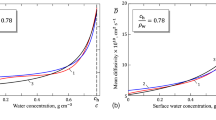Abstract
A one-dimensional model of solute transport through the stratum corneum is presented. Solute is assumed to diffuse through lipid bi-layers surrounding impermeable corneocytes. Transverse diffusion (perpendicular to the skin surface) through lipids separating adjacent corneocytes, is modeled in the usual way. Longitudinal diffusion (parallel to the skin surface) through lipids between corneocyte layers, is modeled as temporary trapping of solute, with subsequent release in the transverse direction. This leads to a linear equation for one-dimensional transport in the transverse direction. The model involves an arbitrary function whose precise form is uncertain. For a specific choice of this function, closed form expressions for the Laplace transform of solute out-flux at the inner boundary, and for the time lag are obtained in the case that a constant solute concentration is maintained at the outer skin surface, with the inner boundary of the stratum corneum kept at zero concentration, and with the stratum corneum initially free of solute.
Similar content being viewed by others
References
Anissimov, Y.G., Roberts, M.S., 1999. Diffusion modeling of percutaneous absorption kinetics. 1. effects of flow rate, receptor sampling rate, and viable epidermal resistance for a constant donor concentration. J. Pharm. Sci. 88(11), 1201–1209, November.
Anissimov, Y.G., Roberts, M.S., 2001. Diffusion modeling of percutaneous absorption kinetics: 2. finite vehicle volume and solvent deposited solids. J. Pharm. Sci. 90(4), 504–520, April.
Barrier, R.M., 1941. Diffusion in and through Solids. Cambridge University Press, Cambridge.
Bass, L., Bracken, A.J., Hilden, J., 1986. Flux ratio theorems for nonstationary membrane transport with temporary capture of tracer. J. Theor. Biol. 118, 327–338.
Crank, J., 1975. The Mathematics of Diffusion, 2nd edn. Oxford University Press, London.
Cussler, E.L., 1997. Diffusion Mass Transfer in Fluid Systems, 2nd edn. Cambridge University Press, London.
Cussler, E.L., Hughes, E.S., Ward, W.J., Aris, R., 1988. Barrier membranes. J. Membr. Sci. 38, 161–174.
Frasch, F.H., 2002. A random walk model of skin permeation. Risk Anal. 22(2), 265–276.
Frasch, H.F., Barbero, A.M., 2003. Steady-state flux and lag time in the stratum corneum lipid pathways: Results from finite element models. J. Pharm. Sci. 92(11), 2196–2207, November.
Guy, R.H., Hadgraft, J. (Eds.) 2003. Transdermal Drug Delivery, 2nd edn. Drugs and the Pharmaceutical Sciences, vol. 123. Dekker, New York.
Hadgraft, J., 2001. Skin, the final frontier. Int. J. Pham. 224, 1–18.
Heisig, M., Lieckfeldt, R., Wittum, G., Mazurkevich, G., Lee, G., 1996. Non steady-state descriptions of drug permeation through stratum corneum. i. the biphasic brick-and-mortar model. Pharm. Res. 13(3), 421–426.
Hosono, T., 1981. Numerical inversion of Laplace transform and some applications to wave optics. Radio Sci. 16(6), 1015–1019, November–December.
Johnson, M.E., Blankschtein, D., Langer, R., 1997. Evaluation of solute permeation through the stratum corneum: lateral bilayer diffusion as the primary transport mechanism. J. Pharm. Sci. 86(10), 1162–1172, October.
Kalia, Y.N., Guy, R.H., 2001. Modeling transdermal drug release. Adv. Drug Deliv. Revi. 48, 159–172.
Lange-Lieckfeldt, R., Lee, G., 1992. Use of a model lipid matrix to demonstrate the dependence of the stratum corneum’s barrier properties on its internal geometry. J. Controll. Release 20, 183–194.
Longer, A.M., Middleton, L.D., Robinson, R.J., 1988. Conventional routes of delivery and the need for devices. In: Drug Delivery Devices; Fundamentals and Applications, pp. 3–15. Dekker, New York.
Magnus, W., Oberhettinger, F., 1949. Formulas and Theorems for the Functions of Mathematical Physics. Chelsea, New York.
Michaels, A.S., Chandrasekaran, S.K., Shaw, J.E., 1975. Drug permeation through human skin in vitro; experimental measurement. IChE J. 21(5), 985–996, September.
Moghimi, H.R., Williams, A.C., Barry, B.W., 1996. A lamellar matrix model for stratum corneum intercellular lipids. ii. effect of geometry of the stratum corneum on permeation of model drugs 5-fluorouracil and oestradiol. Int. J. Pharm. 131, 117–129.
Packer, K., Sellwood, T., 1978. Proton magnetic resonance studies of hydrated stratum corneum. J. Chem. Soc. Faraday Trans. 2, 1592–1606.
Perry, D., Ward, W.J., Cussler, E.L., 1989. Unsteady diffusion in barrier membranes. J. Membr. Sci. 44, 305–311.
Rademacher, H., 1973. Topics in Analytic Number Theory. Springer, Berlin.
Roberts, M.S., Anissimov, Y.G., Gonsalvez, R.A., 1999. Mathematical models in percutaneous absorption. In: Percutaneous Absorption; Drugs-Cosmetics-Mechanisms-Methodology, 3rd edn., pp. 3–55. Dekker, New York.
Schaefer, H., Redelmeier, T.E., 1996. Karger. In: Skin Barrier; Principles of Percutaneous Absorption, Chap. 1.
Sommerfeld, A., 1949. Partial Differential Equations in Physics. Lectures on Theoretical Physics, vol. VI, pp. 63–83. Academic, San Diego, Chap. 3.
Tojo, K., 1987. Random brick model for drug transport across stratum corneum. J. Pharm. Sci. 76(12), 889–991, December.
Tojo, K., Chien, Y.W., 1986. Dynamics of transdermal drug delivery. Proceedings of the 13th International Symposium on Controlled Release of Bioactive Materials, pp. 59–60.
Wakao, N., Smith, J.M., 1962. Diffusion in catalyst pellets. Chem. Eng. Sci. 17, 825–834.
Wax, N. (Ed.), 1954. Stochastic problems in physics and astronomy. In: Selected Papers on Noise and Stochastic Processes, pp. 3–91. Dover, New York.
Author information
Authors and Affiliations
Corresponding author
Rights and permissions
About this article
Cite this article
Mollee, T.R., Bracken, A.J. A Model of Solute Transport through Stratum Corneum Using Solute Capture and Release. Bull. Math. Biol. 69, 1887–1907 (2007). https://doi.org/10.1007/s11538-007-9197-x
Received:
Accepted:
Published:
Issue Date:
DOI: https://doi.org/10.1007/s11538-007-9197-x




